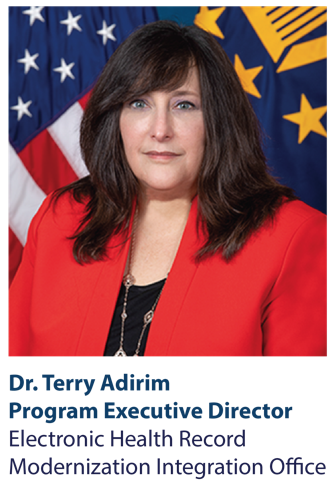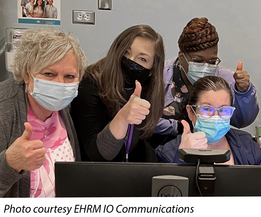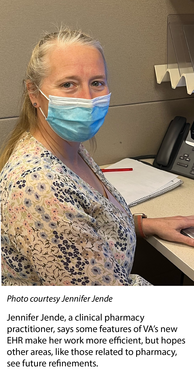
Transitioning to the next phase
Colleagues,
I am extending my sincere thanks to the leadership and staff at the VA Central Ohio Healthcare System for all they have done and will continue to do in support of our latest Electronic Health Record Modernization (EHRM) effort. I continue to be impressed by how quickly personnel have adapted to this change, and the positivity they exuded throughout. We have learned so much from you that we will take forward to your colleagues at future deployment sites.
Thank you, especially, to our clinicians and providers for taking this journey with us and sharing your experience to ensure your colleagues are equally if not more successful in future deployments. Though we may be far apart, your efforts are coming together to fulfill our mission of providing seamless care to all active-duty service members and Veterans.
As we close out this edition of The RoundUP focused on the go-live in central Ohio, let’s look back at how we got to this point and the metrics we’re tracking from the 12 days of go-live.
The road to go-live:
- More than 20 months after the Centralized Scheduling Solution go-live, and 18 months post-deployment kickoff, the VA Central Ohio Healthcare System and supporting remote sites officially went live with VA’s new electronic health record (EHR) system and its full suite of solutions on April 30. This achievement would not have been possible without the preliminary work completed at national and local workshops where local leadership and the Department of Defense (DOD) collaborated with national councils to make hundreds of critical EHR design decisions. Not to be overlooked is the dedication and perseverance of VA, the Federal Electronic Health Record Modernization Office and team members from EHR vendor Cerner, who supported the technical integration to a single, common EHR linking VA, DOD, the U.S. Coast Guard and participating community care providers.
EHR data from the 12 days of go-live:
Here are some statistics, current as of May 12, as we wrap up the second week of going live with the new EHR system in Columbus:
- Veterans and health care providers are steadily adopting the new EHR and its patient portal, My VA Health, to access and use shared information. Over 1,500 messages have been exchanged in the patient portal and more than 13,400 Veterans have signed up for My VA Health.
- Prescription fills and refills are averaging between 1,000 and 1,200 per day and are tracking toward totals before go-live.
- Medication scanning for walk-in patients in primary care increased from 9.3% at the beginning of go-live to 94% with end-user education and support intervention.
- On May 9, the site successfully increased completed appointments by 70%, compared with the previous Monday (May 2).
- On May 10, the facility reached a new milestone, conducting over 1,000 scheduled appointments in a single day for the first time since go-live. More than 870 ambulatory appointments were completed that day, and 75% of Veterans were seen within 30 minutes.
- On May 10, providers saw 10 patients in the operating room, its largest daily patient total since go-live.
Post-go-live support:
Here are two ways to access EHR support after go-live:
1. Call the VA Help Desk at 855-673-4357 and select option 6 to get support from the Cerner Service Desk. (This is preferred.)
2. Submit a ticket online in the yourIT Services Portal.
a. Submitted tickets go to a queue in the Cerner system. Users can view all their tickets under “My Tickets.”
i. To report an issue, select “Normal.” Then select the service under the Category and the EHRM subcategory.
ii. To submit a request, select “Health Services” and the select “EHRM Request.”
b. Tickets and requests will be triaged and sent to the appropriate teams for action.
|

It takes a team
The Women Veterans Health Program team uses VA’s new electronic health record system on May 4, which launched at the VA Central Ohio Healthcare System on April 30. As they grow used to the new system, it is helping them log patient information more quickly.
|
Quote of the day
“I was hesitant about the new system because I had been a user of CPRS [the Computerized Patient Record System] for years. I was scared of change, but this has been a pleasant experience. We are no longer living in the dark ages.”
Dr. Ritu Bakhru, Family Medicine
VA Central Ohio Healthcare System
Patient portal highlights
My VA Health is the new online patient portal for Veterans that allows VA clinicians, staff and community care providers to access a Veteran’s full medical history on a single platform. The information below includes data from May 12. This is the most current report for the VA Central Ohio Healthcare System Go-Live, and data will be rolled up in the My VA Health monthly report moving forward.
Media highlights
Facebook: https://www.facebook.com/VAColumbus
Twitter: https://twitter.com/VAColumbus

Three questions for Jennifer Jende
Jennifer Jende, a clinical pharmacy practitioner at the VA Central Ohio Healthcare System since 2003, helps manage opioid stewardship at the facility. She has served in past roles in Columbus, Ohio, including supporting the pain clinic, helping primary providers manage long-term diseases, and assisting facility operations — all giving her a broad perspective on the new EHR's potential benefits.
During the rollout of VA’s new EHR, Jende is supporting her peers in her role as a “super user,” focused on troubleshooting and placing tickets. Pharmacies face a number of unique challenges during go-live, Jende said, adding that she hopes future updates will address those. Overall, though, the system is already helping many departments work more efficiently, she said.
Now that you’ve started using the new EHR system, how has this improved your workflow?
One thing that is better in Cerner compared to VistA [Veterans Health Information Systems and Technology Architecture] is the Ambulatory Organizer. You can see your patient list in one place and get alerts in one place.
When we think about VistA, if I wanted to go in and see all my patients for the day, depending on the modality of the visit — telephone, virtual, face-to-face — I might have to run different lists. Cerner’s Ambulatory Organizer helps me see all [my] patients in one place at one time, and from that place I can access emails from patients and see alerts from other providers.
I don’t have to log into three different places to see all the info.
What’s your favorite feature of the new system?
I really think my favorite thing is probably that Ambulatory Organizer — to have all that info in one place.
What message would you pass along to your colleagues getting ready to implement the new system?
I have two things for any future site getting ready to go live.
First, take advantage of every training opportunity there is outside the 300- and 400-[level] trainings. Take as much training as your schedule allows. Get in to lunch-and-learns and any other opportunity your facility provides.
Second, try to find a resource at a site that has previously gone live, that is a person you can reach out to about how to implement to your workflow. The reason I say this is because when you do the Cerner trainings in a non-live environment you can’t often go through the steps from “A” to “Z.” So, in your head you think it will work a certain way, but when it is live, what you learned in 300- and 400-[level] trainings will not always make sense. So, you need that peer support who can say, “This is how you actually get it to work.”
I can tell you that without the support we got from VISN 20, that not only our pharmacy, but also parts of our clinical team, would not be as successful as we are. Without getting their tips of, “How this and that has worked, how you can do it,” things would be so much more chaotic.
|
Helpful links
Past issues of The RoundUP
About EHRM (external site)
EHRM VA Insider (internal site)
Columbus VA EHRM SharePoint
My VA Health patient portal | VA Central Ohio Healthcare System | Veterans Affairs
Did you find this information helpful? Do you have questions? We welcome your feedback at EHRMGoLive@va.gov.
|